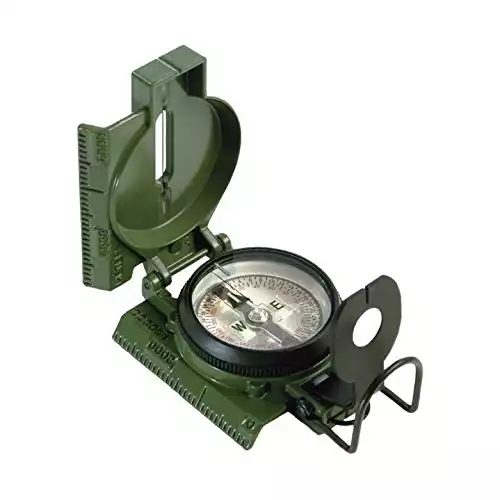Compasses need a bit of training to get the hang of — there’s no getting around that. However, if you have the best survival compass out there — and you know how to use it — along with an up-to-date map, you’ll never get lost.
I’ve spent years using compasses on a daily basis. Whilst serving in the army, a good compass could mean the difference between a good day and a very bad day.
Today, I’m breaking down the best compasses in the world to help you choose the right one. For me, reliability, longevity, and accuracy are the three most important aspects of a good compass, and these check all the boxes.
Survival Compass Reviews
Best Overall
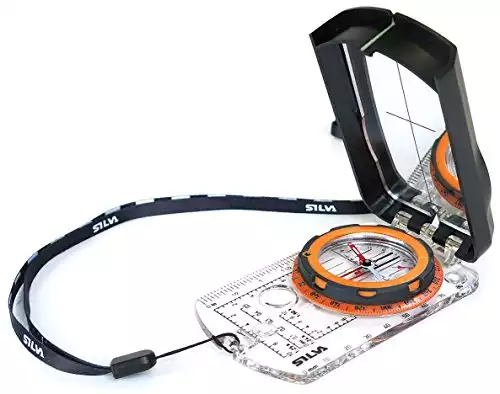
Silva Ranger 2.0 Advanced Compass
Silva has a reputation as one of the best compass manufacturers in the world, but that’s not the reason behind our pick.
This compass combines the best of all worlds. It’s light and portable but not too small to read, it has a mirror that you can use to determine direction (in the field, not just on the map), and it has features for distance and map measuring.
The housing of this compass is turnable, which comes in handy if you need to turn it on your map, while the luminous marks allow you to use it in the dark without a flashlight.
The aforementioned distance and map-measuring features are scaled (1:24k, 1:25k, 1:50k, and 1:62.5k). This allows you to easily measure distance on a map and plan your trip, as long as the compass scale and map scale are the same. For example, if you have a map in the 1:24k scale, you can use this compass’s 1:24k scale to measure distance (1 centimeter on the map is 240 meters in real life).
The included clinometer can measure slopes, a feature experienced outdoorsmen will surely appreciate. Finally, a feature I personally appreciate is the adjuster for magnetic declination.
Magnetic declination is the difference between true north (the direction from where you’re standing towards the North Pole) and magnetic north (the direction in which the compass is pointing, which can be a little bit off because of Earth’s magnetic field lines). This compass recognizes those discrepancies and corrects them.
Simply put, this compass has more features and is more reliable than the vast majority of compasses on the market. Because of this, it goes to the top of the list.
- Magnetic declination correction
- Mirror for determining direction
- Distance and map-measuring scales
- Slope-measuring tool
- High-quality needle glows in the dark
- Light and portable
- Orange markings on orange background
Best Beginner Compass
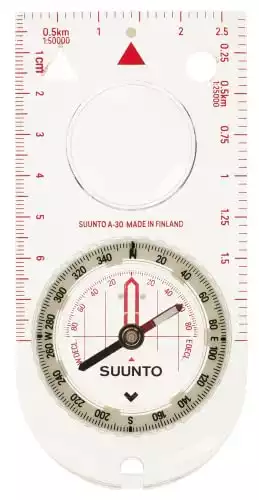
SUUNTO A-30 NH USGS Compass
This is the best compass for beginners because it’s very simple. All the extra features you’ll find on a Silva Ranger may be distracting if you’re new to using a compass. They can also be intimidating.
You don’t need to know how to calculate slope and use a distance measurer to use a compass. Simplicity is key, and that’s exactly what this compass offers.
It has a high-quality magnetic needle with a jewel bearing (jewel bearings slow down needle wear and tear), a scale for magnetic declination, and imperial scales. The latter can be a problem if you’re using a metric-scale map or if you live in Europe, where the metric system prevails.
One downside of this compass is that it’s balanced for the northern hemisphere. So, if you’re anywhere south of the equator, this compass is no good.
However, if you’re just learning how to navigate with a compass, this is a good option, and it’s not expensive either, so you don’t have to invest a lot to start out.
- Simple, easy to use
- High-quality needle
- Magnetic declination scale
- Light and transparent
- Suunto lifetime warranty
- Imperial scale only
- Balanced only for the northern hemisphere
- Will only last for a few years
Best Pocket Compass
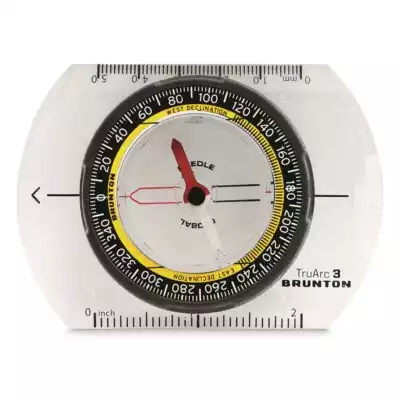
Brunton – TruArc 3 – Base Plate Compass
Brunton is the one of the “Big Three” manufacturers when it comes to compasses. Its products work, and they last.
This compass is an ideal pocket compass. I wouldn’t take it with me on a week-long camping and hiking trip, but if you’re just going for a one-day trip where you don’t expect you’ll even need a compass, this is what you want.
It’s tiny — 2.5 x 3.5 x 0.5 inches — so you can carry it in your breast pocket and forget it’s even there. The compass is accurate (just like all Brunton compasses), and it has a small magnifier for map reading, as well as an adjustment scale for magnetic declination.
I’ve noticed two drawbacks to this compass. First, the compass is tiny! As it should be for a pocket compass, but this may be a problem for people with poor eyesight. However, poor eyesight is going to be problematic with any compass.
Second, the degree markings graduate by two degrees instead of one. This can make your readings a bit inaccurate, but a one-degree discrepancy is unlikely to cause problems in the field.
Overall, this compass fulfills its purpose as a pocket compass well. It was never intended to guide artillery fire or chart 200-mile hikes.
- Tiny
- Accurate
- Small magnifier
- Adjustment scale for magnetic declination
- Could be difficult to read
- Degree markings graduate by two degrees
Best Budget Compass
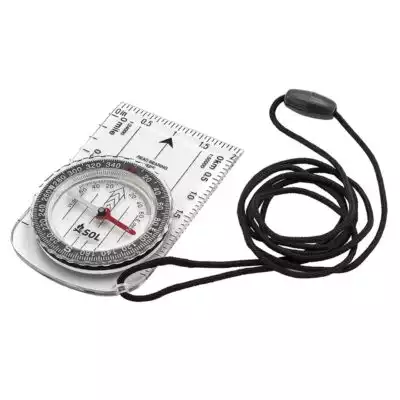
Survive Outdoors Longer Map Compass Hiking Gear Survival – (Pack of 3)
This compass works just fine. However, as a budget compass, it doesn’t have much else going for it. It’s going to get the job done, but not much else.
It won’t last for a decade, it doesn’t have a backlight or an automatic magnetic declination adjustment, it’s liquid filled (which means the needle won’t work at freezing temperatures), and it’s intended for use only in the northern hemisphere.
Don’t get me wrong — this isn’t a bad compass. The price is absolutely fantastic and, unlike many more-expensive compasses, it includes both metric and imperial measurements for map reading.
It’s just not a compass you’ll buy if you’re a serious outdoor adventurer who needs a long-term reliable product. However, if you need a compass that will get the job done and your budget is limited, this is the compass you want.
- Very cheap
- Accurate needle
- Imperial and metric measurements
- No automatic magnetic declination adjustment
- Short-term option only
- No backlight or phosphorescent lighting
- Can’t be used at freezing temperatures
- Limited to the northern hemisphere
Buyer’s Guide: What to Consider When Buying a Survival Compass
Benefits Over GPS
This has to be the most common question people have when discussing compasses. You have a quicker, easier, and arguably more accurate option in a GPS device. Since we all have them on our phones, you don’t even have to buy an actual device (although that depends on how reliable your phone is).
So, why should you spend money on a compass?
- Compasses are not battery powered, so they won’t die.
- Compasses don’t need cellular reception to work.
- Compasses are a reliable backup to GPS devices.
- Knowing how to use old-school navigation techniques is a crucial skill for anyone interested in wilderness survival.
Don’t get me wrong — I’ll always use a GPS if it’s available, but what if it isn’t?
For comparison, consider this: I’d rather cut a tree down with a chainsaw than with an ax, but what’s going to happen if your chainsaw breaks down and you don’t know how to use an ax?
Reliability
Look for brands that offer warranties. A warranty indicates that a brand expects its compass to last. Most reliable compass manufacturers provide a warranty for their products.
I’ll always opt for brands that will replace my product if it arrives damaged or if it simply stops working after a while over brands that won’t do that.
Suunto, Brunton, Silva, and Cammenga are known for making long-lasting products.
Durability
When we talk about durability, we need to consider the materials used to make the compass. Cammenga’s military compass is built with an aluminum frame, making it more durable.
This is a massive plus in my book. If a compass will stop working because you accidentally dropped it once, it’s not a good compass, and it can’t handle difficult situations.
The other compasses mentioned in this article are made from hardened, transparent plastic. That’s useful because you can see your map through the compass, but hardened plastic isn’t nearly as strong as aluminum.
Purpose
This is the question you need to ask yourself: “What do I need this compass for?”
If you don’t regularly find yourself in extreme environments, there’s no point in investing in Cammenga’s military compass. If you’re learning how to use a compass, there’s no point in investing in a SILVA Ranger 2.0, an advanced compass.
This is a question we all need to ask ourselves whenever we’re buying any type of survival gear: Is this going to fit the purpose I need it for?
Read more about compass types
Basic Features
Make sure the compass you’re buying has these basic features (unless you’re buying a budget compass):
- A functional needle
- Declination adjustment feature
- Scale measurements (preferably in both imperial and metric units)
- Appropriate hemisphere functionality
Here are some additional useful but not absolutely necessary features to consider:
- Glow-in-the-dark needle and numbers
- Mirror
- Prepared standardized scales
- Slope-measuring tool (clinometer)
- Rotating bezel
- Magnifying tool
Summing Up
Using a compass is actually super easy once you get the hang of it, and all the compasses on this list are good for the purposes they were designed for. The SILVA Ranger 2.0, however, has to be the top choice just because of how versatile, well-made, and all around useful it is. If you know how to use all the features it offers, there’s no way you’re getting lost in the wilderness.
Another compass I’d point out is the SOL Map Compass. It’s not as developed as my other picks, but I’m pretty sure you won’t find a better compass for such a low price.
Either way, choose one of these survival compasses and get out there!


